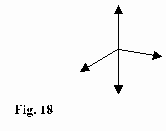
5.3 From the structure of the electron to its mass
5.3.1 The discovery of the connection between the 3 K-background-radiation of the cosmos and the de-Broglie-wave-length of the electron
First, it was only intended to include the red-shift, the deflection of light and the constant of gravitation in the theory. But the calculation of the constant of gravitation was not possible without the more detailed consideration of the connection of radiation and mass.
For this consideration it seemed to me that the electron has the quality of being a suitable object of an investigation because it is close connected with the radiation. It shows us the light after all. The structure of the electron based on defined particles was of interest to me.
Therefore, I looked for the connection between the structure of the electron based on particles and the mass of the electron. To get the mass I decided to take energy into my mode. To get the energy, I had to determine the number of components of type l and their wave-length.
.
I went through 5 sections and it was like the search for the way in the mist:
1. Section:
Assumption: The structure is based on 4-particle-collisions and within it is 3-dimensional:

Because 3-particle-collisions are more common as 4-particle-collisions, this structure was no longer considered. Furthermore, a 3-particle-collisions-structure formed as a plan fits better between the 3 K-space, on that the structure is supported, and a nuclear-structure probably being a spacial 4-particle collision-sructure (Fig.18)
2. Section:
Assumption: The structure based on a plan 3-particle-collision (Fig.19):
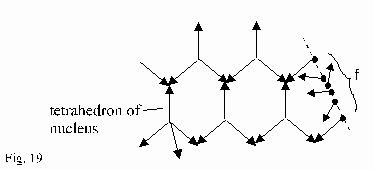
3. Section:
The distance f must be so big that there is in accordance with the 3 K-space in refer to the supporting particles coming from the 3 K-space.
4. Section:
Determination of "f:"
To meet the conditions for one lmax
(3 particles with a determined distance and a determined direction) the number
of  steps are needed according
to the following drawing (Fig.20):
steps are needed according
to the following drawing (Fig.20):
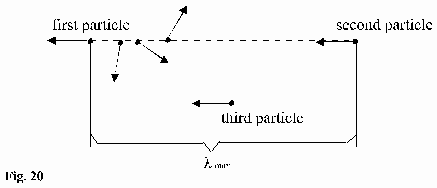

Remark: These values result from the first used values for
T=3oK and lmax =0.9666*10-3
m (by using the equation:
![]() )
/4/
)
/4/
The values of COBE were used later on a more precise calculation. These values were also the basis for developing the theory.
There is one hit ( one lmax ) at 1.9548*108 experiments.
Description of this fact by probabilities:
The condition: "3 particle with a determined distance and a determined direction" can be written as:
[The 1st particle has the direction"
![]() " and a determined distance
to particle 2] =probability p1
" and a determined distance
to particle 2] =probability p1
[The 2nd particle has the direction"
![]() " and a determined distance
to particle 3] =probability p2
" and a determined distance
to particle 3] =probability p2
[The 3rd particle has the direction"
![]() " and a determined distance
to particle 1] =probability p3
" and a determined distance
to particle 1] =probability p3
The probability of a hit of lmax is described by the following equation.

The conditions of the determination of "f" is as follows (shown also in Fig.21):
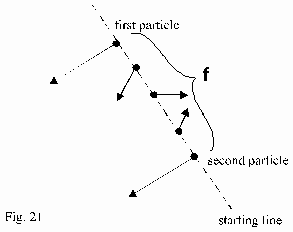
[The 1st particle has the direction"
![]() " and a determined distance
to particle 2] =probability p1
" and a determined distance
to particle 2] =probability p1
[The 2nd particle has the direction"
![]() " and a determined position
to particle 1] =probability p2
" and a determined position
to particle 1] =probability p2
The term "determined position" means the "starting line".
There is one hit after the number of
 experiments.
experiments.
The probability is as follows:

respectively the number of experiments
![]()
Hence it follows:
![]()
and
![]()
5. Section:
Number of elements of structure (components of the type l ; look also Fig.19)
The structure of the electron consists of a number of particles of structure supporting inwards the nucleus and outwards the 3 K-space. Many particles can take part in the building of the structure until the structure is destroyed by a 3-particle-collision. Those two particles that are alien to the structure must have a determined distance and a determined direction relating to the target-particle of the structure.
But this is the same condition used for the determination of " f "(as shown in Fig.22).
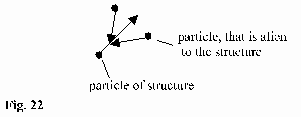
Considering this, a structure supporting the nucleus is destroyed after 3.363*105 experiments on average. In this case the term "experiment" is identical with the term "particle of structure". This is independent from the form of the structure.
It is assumed that two structures are supported at each point of tetrahedron of an nucleus. As shown simplified in Fig.23:

Herewith the number of particles that take part in the structure
is 4*2*3.363*105=2.69*106 .
For the conversion of this number of particles into energy and finally into mass, groups of three particles have to be formed (see also chapter 2). The number of these groups is 8.97*105.
It is suitable to use the term "f"as length of wave l of these groups of three particles because the directions of the particles 1 and 2 can also be in this mode (Fig.24).
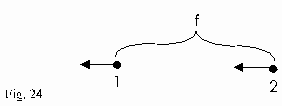
l=1.663*10-6 m
The energy of the supporting structure is consequently:
![]()
The mass
![]()
Because this value is very close to the known mark of 9*10-31 kg , the figures in the equation above was replaced by symbols. With that the physical contents should be better recognized.
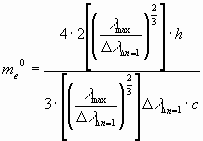
![]()
Except the factor
![]() the term
DlDn=1originating
from the 3-K-space surprisingly represents the "de-Broglie-wave-length" of the
electron.
the term
DlDn=1originating
from the 3-K-space surprisingly represents the "de-Broglie-wave-length" of the
electron.
Now the sun was shining again.